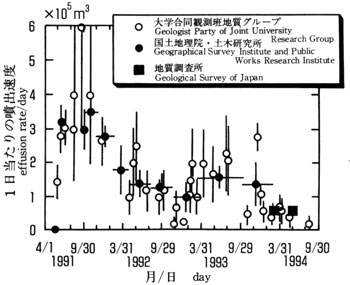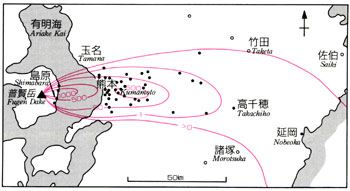Unzen Volcano
Introduction / Geology and petrography of Asama Volcano and environs / Outline of Unzen volcano
Older Unzen volcano / Younger Unzen volcano
Eruptions of 1663-64 and 1792 / Eruptions since 1990
Surveillance and observation of volcanic activities / Concluding remarks
References
![]() PREV
PREV ![]() NEXT
NEXT
Eruptions of 1663-64 and 1792 / Eruptions since 1990
Eruptions of 1663-64 and 1792
Three historical eruptions including current activity are known for Fugendake. In 1663 ( 3rd year of Kanmon ) Furuyake lava ( andesite ) erupted from just inside of collapse wall NE of Fugendake and flowed down 1 km to north. This lava is characteristic in that its SiO2 is low and contains olivine phenocrysts. The next year Antoku, a small village at the mouth of Mizunashigawa river, was flooded by water from Kujukushima pond ( crater ) resulted in 30 strong deaths. Seismic swarm started from November 1791 near Obama ( western peninsula ) culminated in an eruption with column of smoke from Jigokuato crater in January 1792 ( 4th year of Kansei ). In February Shin'yake lava ( dacite ) erupted from NE of Fugendake and the length of lava flow reached 2 km by April. At the end of April frequent earthquakes hit Shimabara causing cracks in the ground. On May 21st, Mayuyama, on the back of Shimabara collapsed and debris avalanche hit built up area of Shimabara ended up in Shimabara Bay. By this avalanche an area 4 km long by 1 km wide was reclaimed from the sea and many small islands ( Tsukumojima islands ) were formed. A tsunami originated from this avalanche crossed the sea and hit Higo region ( now Kumamoto Prefecture ) on the other side of the Shimabara Bay resulting in about 15,000 deaths, the largest casualty in the volcanic disasters in Japan. The disaster was called 'Shimabara trouble, Higo horrible'.
Eruptions since 1990
Phreatic explosion on November 17 1990: Since 1989 seismic activities became active around Unzendake and volcanic tremors were observed in July 1990. On November 17th smoke columns mixed with volcanic ash reaching 200 to 300 m high erupted from two craters of Jigokuato and Kujukushima. From the craters sand, gravel and cinders were ejected. The smoke column activities rapidly became weak and together with volcanic tremor all activities stopped in a week.
Phreatomagmatic explosion on February 12 1991: A new crater-forming eruption at Byobuiwa NE of Fugen Shrine commenced on February 12th. Violent rise of smoke column containing a quantity of ash reaching several hundred meters occurred. Although little in amount, fresh glass was contained in ash indicating it was phreatomagmatic eruption. After April the Jigokuato crater had been enlarged with violent eruptions involving sand and gravel.
After May 1991: Appearance of lava dome and outbreak of pyroclastic flow: In the middle of May volcanic earthquakes occurred frequently below the Jigokuato crater with formation of ground fissures. On May 20th lava appeared at the bottom of Jigokuato crater. The lava started to tumble down the headwater of Mizunashigawa river overspilling crater rim. High temperature lava masses were comminuted during tumbling down and became a mixture of ash, air, and gas: that is, pyroclastic flow, and rushed down the slope ( 24th ). The pyroclastic flow reached farther and farther, and on June 3rd a large scale pyroclastic flow developed comfbining the eastern half of the dome and part of existing mountain together. Many people including media reporters at Kita-Kamikoba area became victims and number of combined dead and missing were counted to be 43. After the collapse of lava dome within the resulting horse shoe shaped topography formed a new lava dome ( Second lobe ) and grew along the slope. On June 8th the lava dome fell like landslide and part of the dome exploded, as sudden decompression took place ( ![]() Fig. 2 ) and cinders showered built up areas of City of Shimabara. On August 13th third lobe erupted on second lobe started falling into Oshigadani, NE of the dome resulting in a pyroclastic flow on September 15th reaching 5.5 km destructing Onokoba Primary School building by fire. At the same time fourth lobe appeared inside of the collapse wall and grew along the slope reaching 500 m in length. Fifth lobe then appeared on top of fourth lobe and from there pyroclastic flow went down along Akamatsudani to the south. Following the above incidents, sixth to ninth lobes appeared to the south slope of fifth lobe. Pyroclastic flows ran down the Akamatsudani valley and filled it. From November 1992 to January 1993 frequency of pyroclastic flow activities and the amount of erupted lava decreased, but became active again from February when tenth lobe was formed followed by extrusion of eleventh lobe in March on third lobe. Pyroclastic flow again started to flow down to the NE side gradually burying Oshigadani valley and finally reached to Senbongi area crossing Tarukidaichi Plateau. On June 23-24 1993, southern side of eleventh lobe collapsed one after another forming pyroclastic flow. Many houses in Senbongi area were burnt down with one casualty. Between June 26 and July 19, south side of eleventh lobe collapsed and resultant pyroclastic flow came down along Mizunashigawa river and stopped beyond National Highway 57. This was the longest distance for a flow. After that in January 1994, twelfth lava lobe was formed and thirteenth at the beginning of July. The distributions and positions of lobes are shown in
Fig. 2 ) and cinders showered built up areas of City of Shimabara. On August 13th third lobe erupted on second lobe started falling into Oshigadani, NE of the dome resulting in a pyroclastic flow on September 15th reaching 5.5 km destructing Onokoba Primary School building by fire. At the same time fourth lobe appeared inside of the collapse wall and grew along the slope reaching 500 m in length. Fifth lobe then appeared on top of fourth lobe and from there pyroclastic flow went down along Akamatsudani to the south. Following the above incidents, sixth to ninth lobes appeared to the south slope of fifth lobe. Pyroclastic flows ran down the Akamatsudani valley and filled it. From November 1992 to January 1993 frequency of pyroclastic flow activities and the amount of erupted lava decreased, but became active again from February when tenth lobe was formed followed by extrusion of eleventh lobe in March on third lobe. Pyroclastic flow again started to flow down to the NE side gradually burying Oshigadani valley and finally reached to Senbongi area crossing Tarukidaichi Plateau. On June 23-24 1993, southern side of eleventh lobe collapsed one after another forming pyroclastic flow. Many houses in Senbongi area were burnt down with one casualty. Between June 26 and July 19, south side of eleventh lobe collapsed and resultant pyroclastic flow came down along Mizunashigawa river and stopped beyond National Highway 57. This was the longest distance for a flow. After that in January 1994, twelfth lava lobe was formed and thirteenth at the beginning of July. The distributions and positions of lobes are shown in ![]() Fig. 3, and the volume of lava is shown in
Fig. 3, and the volume of lava is shown in ![]() Fig. 4.
Fig. 4.
Ejecta: All the erupted lavas are dacite with phenocrysts of plagioclase, hornblende, biotite, quartz, and magnetite. Bulk rock compositions are comparatively homogeneous and within a narrow range of SiO2=63.5 - 65.5 % since the beginning of latest activity. The ejecta include lava, pyroclastic flow derived from collapsed lava dome, talus, and ash created from pyroclastic flow movement and deposited on the downwind sides. Ash fall deposit derived from pyroclastic flow of June 3rd 1991 at 16:08 hours reached Nobeoka City in Miyazaki Prefecture. In ![]() Fig. 5 is shown distribution of ash fall deposits accompanied with pyroclastic flows.
Fig. 5 is shown distribution of ash fall deposits accompanied with pyroclastic flows.



